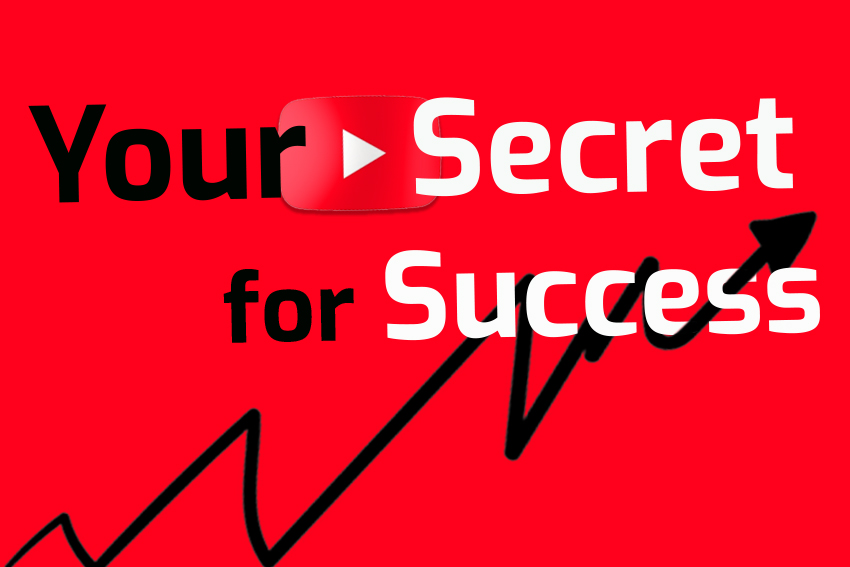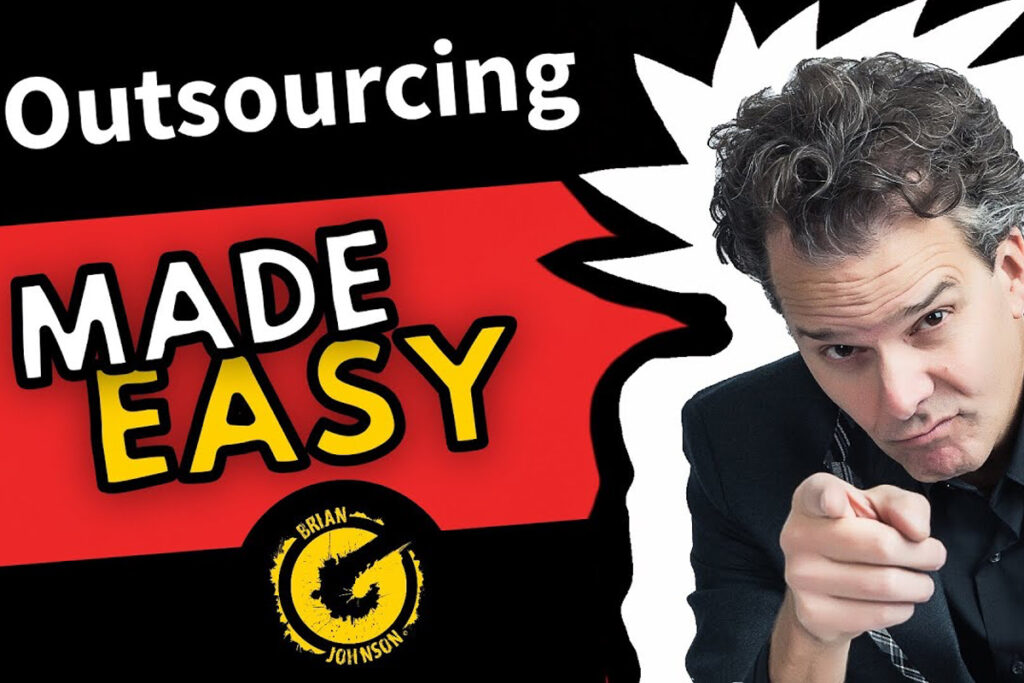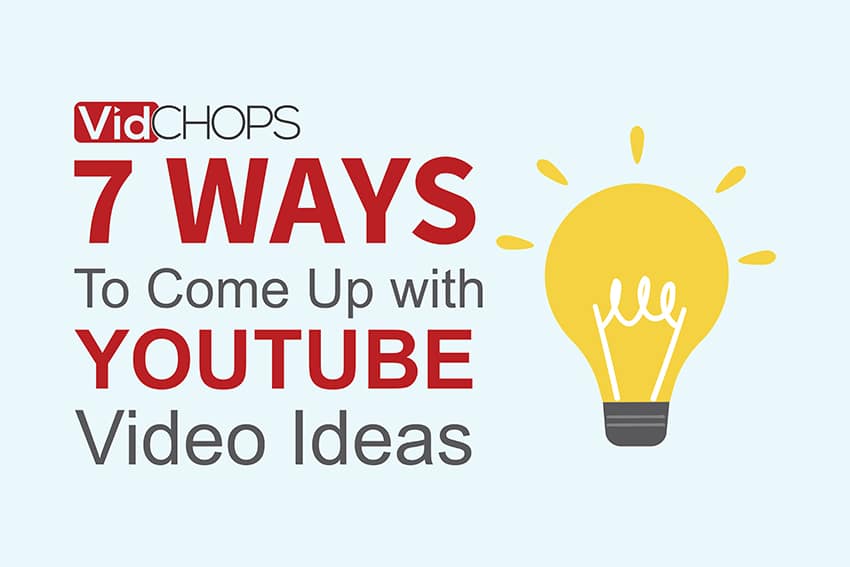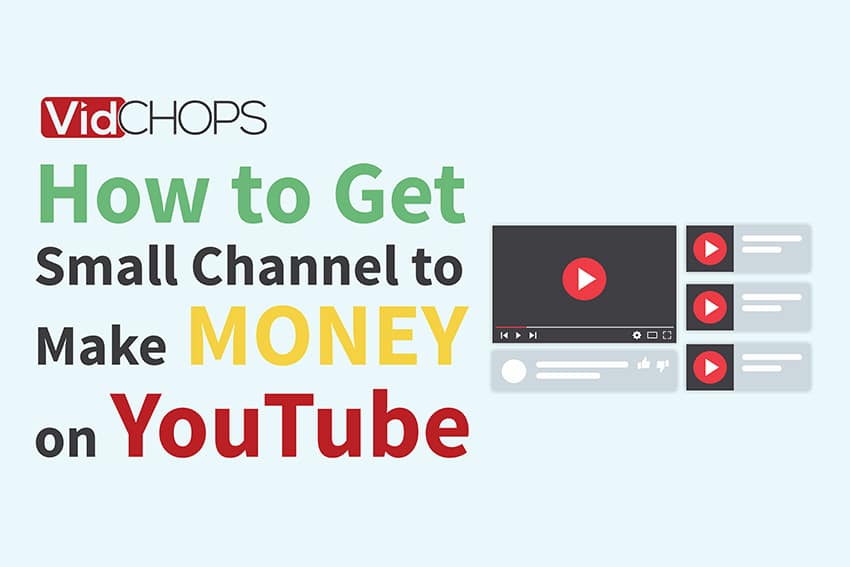How Top Video Creators Turn Simple Views Into 7-Figure Businesses
We break it all down on The Video Creatr Show, click the link below.

Introduction
In this article, you’ll learn how to tap into a rich vein of viewers with a YouTube for Business channel. We’ll teach you best practices for each step of the journey as well as the nuts-and-bolts of how to set up your channel and the types of videos you should use. You’ll also discover how to repurpose your painstakingly-crafted videos for other social media platforms by yourself or with the help of the Vidchops video editing service.
Why should you use YouTube to grow your business?
Video captures people’s hearts and nudges them to make buying decisions. In fact, 80% of YouTube viewers say video helps them make a purchase decision. Facts tell, but stories sell. And YouTube helps businesses tell their stories.
Boasting two billion viewers, YouTube is the world’s second-largest search engine, right behind Google (which can show your YouTube videos). It’s also the world’s second-largest social network, and it reaches more adults aged 18-49 than cable TV.
Another reason to jump on the YouTube bandwagon is that people engage with video more than other forms of content (written, audio, images, etc.). With an average session duration of almost 9.5 minutes, YouTube retains eyeballs and interest more than most other social networks.
Is YouTube the right place for your videos?
Given YouTube’s global reach, it’s a great place to house your videos, but the best practice is to use it as part of a dual strategy. Use a video platform to keep everything organized, but promote your video content on YouTube.
Establish a purpose for your YouTube presence
When you’re clear about what you want to accomplish, YouTube can be a big revenue or lead-generation opportunity. A purpose-driven, well-curated channel can inform, educate, and entertain people anywhere along their customer journey. So before you start the simple process of setting up a YouTube for Business account, take time to decide on your goals.
Do you want to accumulate subscribers, gather leads for direct sales or follow-up, or drive downloads? Or do you have another overarching objective? Make the decision, and tailor your content to reach that objective.
Marketing writer Ryan Holiday warns, “Nothing has sunk more creators than this: Our inherently human tendency to pursue a strategy aimed at accomplishing one goal while simultaneously expecting to achieve other goals entirely unrelated.”
Remember: On YouTube, it pays to pick one thing and do it really well.How does YouTube for Business work?
YouTube marketing is based on the channel. Think of the channel as a miniature website for your business. This is where you’ll curate the videos, images, and descriptions your visitors will see. If visitors find your videos somewhere else and like them, they’ll likely wind up on your channel.
Five best practices for creating a YouTube for Business Channel
1- Decide on your channel’s primary purpose
(see the Establish a purpose for your YouTube presence section above).
2- Give your company its own Brand Channel.
Although User Channels and Brand Channels are different, they’re often treated interchangeably. Make sure to do this right from the outset. If someone sets this up as a User Channel under their personal email, they can take it with them if they leave.
3- Brand it as your own website. You want to establish a consistent image for your brand everywhere visitors interact with it. So it’s a good idea to give your channel and your website the same header image.
4- Actively manage the channel. Make it easier and more engaging for users to interact with your videos. Add, hide, or edit videos on an ongoing basis, and use tags on both your channel and your videos. Those best practices help you stay organized, and YouTube will reward you with more recommendations.
5- Promote your work. Post your YouTube videos on other social networks or link to them in your email campaigns to get things moved. And once you’ve got some traction on YouTube, you can edit those videos into new content to post on other social media sites (check out the Repurpose your YouTube content and An easier way to repurpose your YouTube content
sections below for further details).
What types of videos should I upload to my YouTube?
You can upload three types of videos to YouTube. Which type you’ll choose depends on your purpose. Here are the types of videos
- YouTube in-channel videos
- YouTube Live (otherwise known as YouTube Livestreaming)
- YouTube ads
YouTube ads are the brief messages that appear before, during, or after the content, viewers want to watch. They are peripheral to many YouTube for Business channels, so we’ll focus on YouTube in-channel videos and YouTube Live.
YouTube in-channel videos introduction
YouTube in-channel videos are, as you’d expect, the videos you upload to your channel. When you think of creating content for YouTube, this is likely what you’ll think of first. People search for in-channel videos, and you’ll use them to attract an audience.
To encourage people to watch a series of videos, organize them into playlists. Remember, the organization helps your audience to find you, YouTube to recommend you, and your company to give your brand channel structure.
In-channel videos specs
Shoot for your YT videos to be around 1280×720 pixels. Users can comfortably view videos of that size on a smartphone. The smallest videos you can upload are 426×240 pixels, and the largest is 3840×2160 pixels.
The YouTube player aspect ratio, known as widescreen, is 16:9. If you’d like, you can use the more dated 4:3 aspect ratio or the newer-looking vertical video. YouTube will make your video fit if necessary by adding black bars to the sides so there’s no white space. That process, by the way, is known as pillar boxing.
Quick question: Why not just upload existing videos to YouTube?
Of course, there’s no law against that, but don’t expect stellar results unless those videos already include hooks, are in widescreen format, and have exciting thumbnails. If you want to reuse videos, you could cut a long video into a trailer. Then post the trailer on YT and direct viewers to the full video. Better yet, to get maximum use out of your existing videos, turn to video editing service Vidchops. They’ll turn your ho-hum videos into professional-looking content ready to rock your audience!A few best practices for in-channel YT videos
Commit to a publishing schedule.
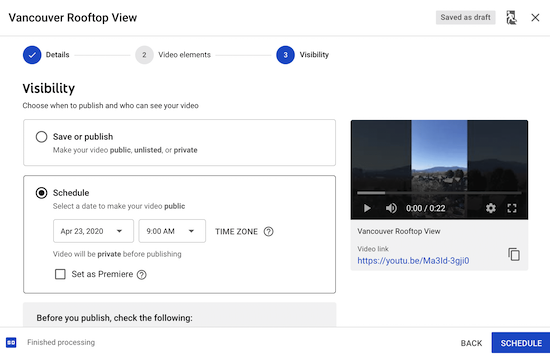
Start small at first, like uploading two new videos a month. It’s better to under-promise and over-deliver than vice-versa. Once you’re more comfortable with the process and know you can comfortably post more videos, ramp up your schedule. Your viewers will come to trust you as you follow your schedule. Over time, you’ll build up a video library people will want to explore and revisit.
Use YT keywords to create content.
To gain a little inspiration, type keywords into YouTube’s search bar. View those recommended videos and use them to inspire your next YT project. Also, when your video ends, check out the YouTube suggests you follow up with. Use Google Trends to pinpoint hot topics.
Focus on your thumbnail and your title.
If the title and thumbnail don’t capture people’s attention, it’s unlikely they’ll spend more time on your video. In the words of the late, great David Ogilvy: “80% of readers only read the title. It follows you should spend 80% of your effort there.”
When you craft your thumbnails, think of images that will create curiosity. In the 1950s, advertising legend Ogilvie added a five-cent eyepatch to a Hathaway shirt model to turn an image from a product photoshoot into a story. The campaign was a runaway success, and it’s an iconic example of the value of embedding detail and story into your content.
Make videos to meet your goals.
For instance, if you want subscriptions, end videos with a call to action to subscribe. If you’re after downloads, measure those with your marketing system. Remember to focus on your channel’s primary purpose.
Add a featured video, a channel description, your logo, and links.
If you begin to garner a decent amount of traffic and views, request to start a partner-verified account. That will expand your videos’ reach.
Cultivate your channel.
Just like you’d weed and maintain a garden, cultivate your YouTube channel. Add tags to your channel and your videos, and check all the boxes YouTube offers. Integrate Google Analytics to track your channel’s performance. Note which videos get the most views, shares, and comments. You may want to expand or repurpose that content.
YouTube Live (otherwise known as YouTube Live Streaming)
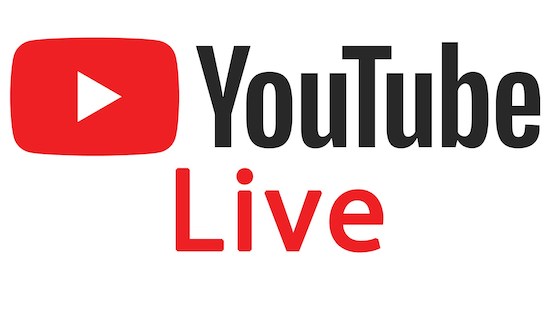
YouTube launched YouTube Live in 2008, but only in the past few years has the live-streaming feature gained traction. Viewers now consume as much video content as possible as it happens. Of the 100 most popular YouTube live streams, over half of them took place in the last two years.
You don’t have to host a concert or a blockbuster event to use a Livestream. Businesses turn to live streams to deliver news, product updates, or exclusive behind-the-scenes peeks.
YouTube Live Specs and Tech
Just like in-channel videos, a 1280 x 720-pixel webcam will provide an adequate viewing experience. But if you’re using YouTube Live 360, a service that allows people to watch videos from their virtual reality headsets, you need to up the resolution to at least 1440 pixels.
YouTube Live is only available to channels with 1,000 or more subscribers. You’ll need to download YouTube’s encoding software on your recording device and set your channel up for livestreaming.
A few YouTube Live best practices
Promote, promote, and promote some more!
At the start of the livestream, your channel’s subscribers will be alerted through the app and, unless they’ve disabled it, push notification. But that’s just icing on the cake. To make sure the livestream attracts an audience, promote it heavily leading up to the event.
Choose a time that works for your audience.
If your livestream targets businesspeople put it on during the workday. For consumer audiences, choose weekdays at lunch, in the evening, or on weekends.
Practice ahead of time.
Instead of just hoping for the best, stage a full-scale dress rehearsal to iron out as many technical glitches as possible. Today’s tech-savvy audiences will tolerate a mistake or two, but not a slew of them.
Enable DVR.
That way, subscribers who miss the livestream can catch it later. You can also cut out the best clips from the livestream and repurpose them for other videos.
Reward your live viewers with something unique.
It takes time and attention—two items that are in short supply for most people—to tune in to a livestream at what might be an inconvenient time. Make it worth your viewers’ while to tune in. In most cases, a livestream offers viewers an exclusive backstage view that they wouldn’t otherwise see. at a concert or conference. Live works well for big announcements, product launches, interviews, and product demonstrations.
Repurpose your YouTube content
How should this data inform your approach to creating content that your audience values, that spotlights you as an industry leader or expert, and lets you cash in on content and social media marketing? One answer is to repurpose your content. Here’s how you can start repurposing your YouTube videos for multiple platforms.
After your video is ready, use a service like Rev to transcribe it. Rev is $1 per minute. Although there are cheaper services out there, Rev has a fast turnaround time and produces high-quality work.
Next, extract the audio from your video. Use Audacity (free open-source software) to do that. For step-by-step directions, go here.
With video, audio, and written content, you’ll have the perfect trifecta to populate your blog, Instagram, Pinterest, Facebook, and other networks.
An easier way to repurpose your YouTube content
Vidchops offers a best-in-the-business 48-hour turnaround time, expert video consulting, included stock video and audio, and other features that will exceed your expectations. To learn more and access special offers, click here.
